Season-Resolved, Fluctuation-Level Regional Connectivity of PM2.5 over the Korean Peninsula Revealed by Multifractal Detrended Cross-Correlation Networks (2016–2020)
Abstract
1. Introduction
2. Materials and Methods
2.1. Data Sampling and Processing
2.2. Methodology
2.2.1. Daily Climatology Detrending
2.2.2. Removing the Wide Effect (EOF1 Residuals)
2.2.3. Multifractal Detrended Cross-Correlation Analysis (MFDCCA) and
2.2.4. Significance via iAAFT Surrogates
2.2.5. Signed, Weighted Network Construction
- All-edged network (signed): with both positive and negative weights.
- Positive subgraph: .
- Negative subgraph: (magnitudes as weights).
2.2.6. Global Network Measures
- (1).
- Edge density: , with as the number of nonzero edges. This quantifies the overall connectivity of the PM2.5 system. A higher density suggests that most monitoring stations exhibit significant cross-correlations with one another, implying a highly interconnected and potentially uniform regional pollution system.
- (2).
- Mean absolute weight: . This measure quantifies the average covarying strength among all significant edges. A higher value indicates a high synchronization.
- (3).
- Weighted characteristic path length : Shortest paths are computed on distances (for connected pairs) then averaged over all node pairs in the largest connected component [26]. This quantifies the global integration/efficiency of a network, implying that a smaller value indicates the closeness of connectivity.
- (4).
- Degree assortativity (weighted): Newman’s assortativity is computed on node strengths (weighted degree), as an average correlation of endpoint strengths across edges [27,28], that is, . Assortativity () means nodes with high overall correlation strength tend to connect to other high-strength nodes (that is, major pollution centers synchronize). Disassortativity ( means high-strength nodes tend to connect to low-strength nodes (a major source site influences many minor sites).
3. Analysis Results
3.1. Spring (MAM)
3.2. Summer (JJA)
3.3. Autumn (SON)
3.4. Winter (DJF)
3.5. Network Summary and Link to Global Metrics
4. Discussion
4.1. Season-Resolved Connectivity and Meteorological Controls
4.2. Alignment with Annual Features: Year-by-Year Connectivity
- The seasonal dominance persists across years. Even when analyzing calendar years, the winter–spring connectivity remains the first-order structure, matching the transport/accumulation regime emphasized by the backward trajectory evidence in the work of Allabakash et al. [29].
- The signed structure is robust. Assortative positive backbones and NW–SE anti-phase negative links recur each year; their edge density and mean |w| vary inter-annually, plausibly reflecting the synoptic frequency, boundary layer depth, and precipitation differences [15,16]. For example, years with more persistent cool-season haze episodes show denser 15–30-day networks, whereas years with weaker synoptic support display attenuated connectivity—qualitatively consistent with annual narratives in Allabakash et al. [29].
- The statistical power is stronger in annual windows. A single year provides fewer boxes at 15–30 days, reducing the surrogate test power versus the season-pooled (cut-and-stitch) design. Thus, the year-wise connectivity is concordant with the seasonal organization but naturally noisier at the largest analyzed scales.
4.3. Seasonality vs. Annual Features: Comparability and Limitations
4.4. Mechanistic Synthesis and Implications
5. Conclusions
Author Contributions
Funding
Data Availability Statement
Conflicts of Interest
Appendix A
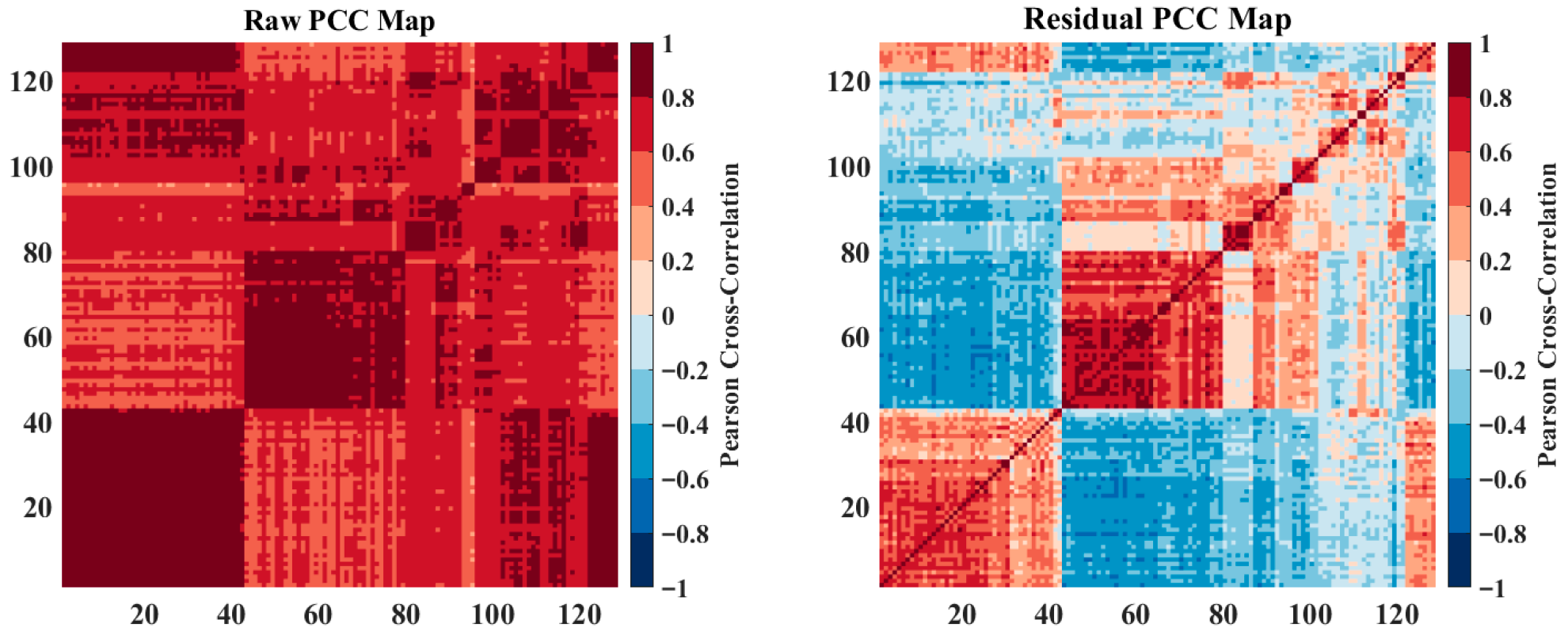

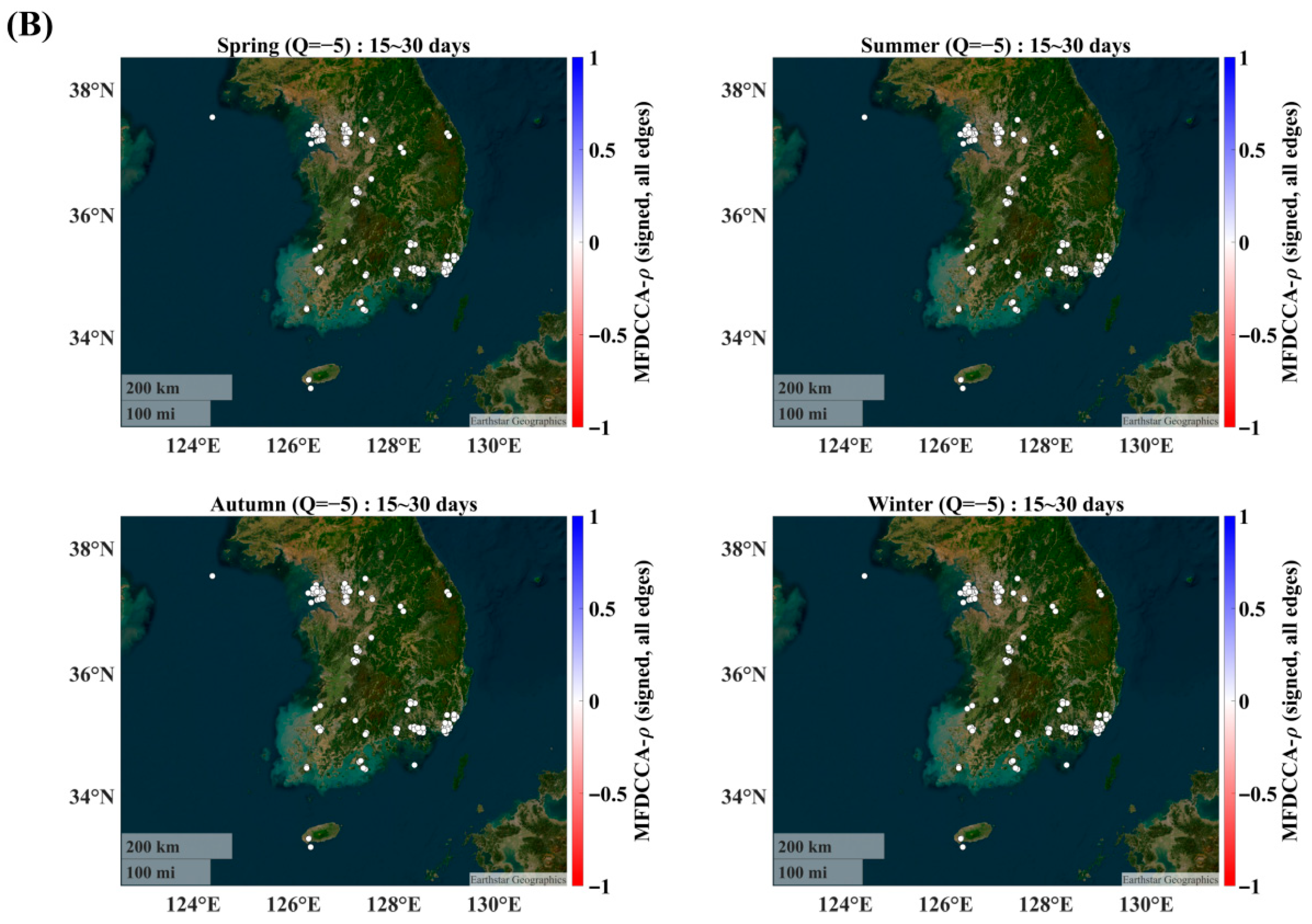
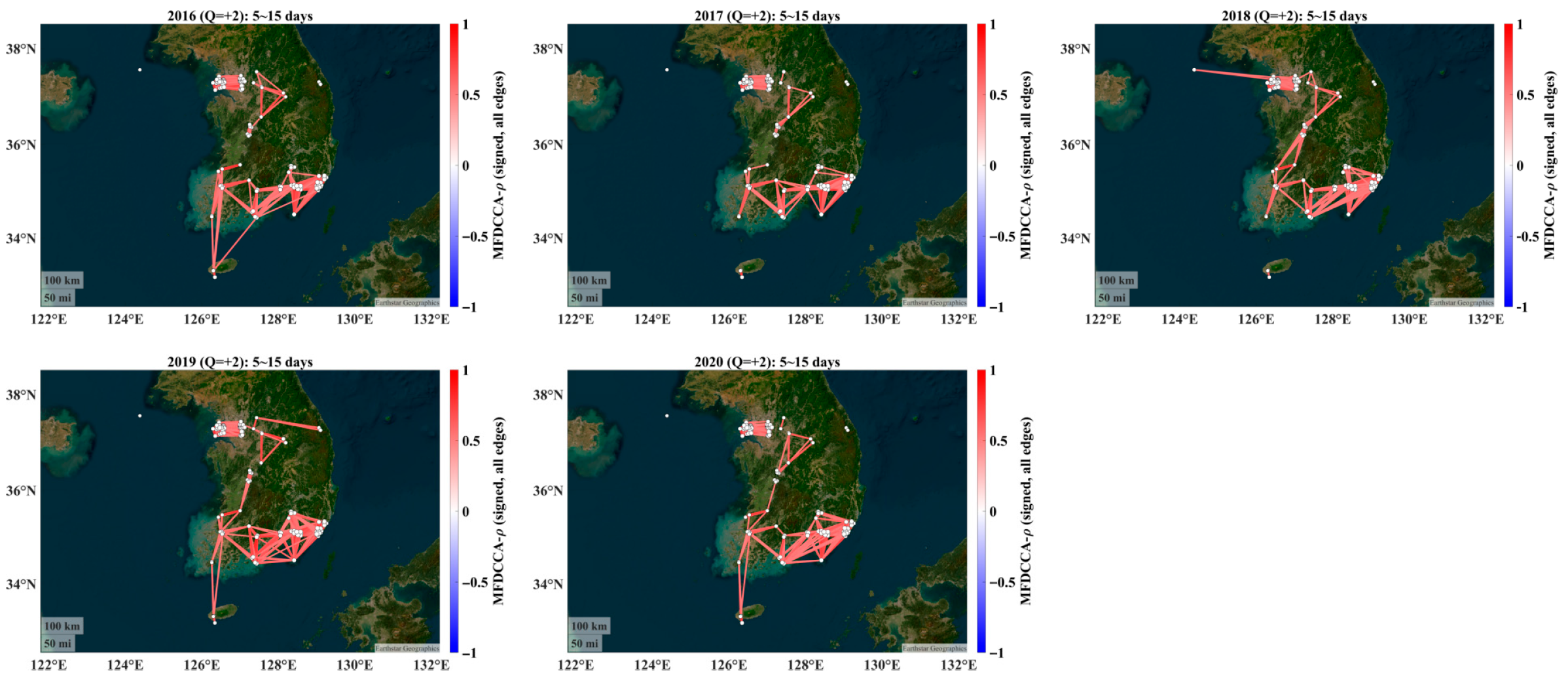
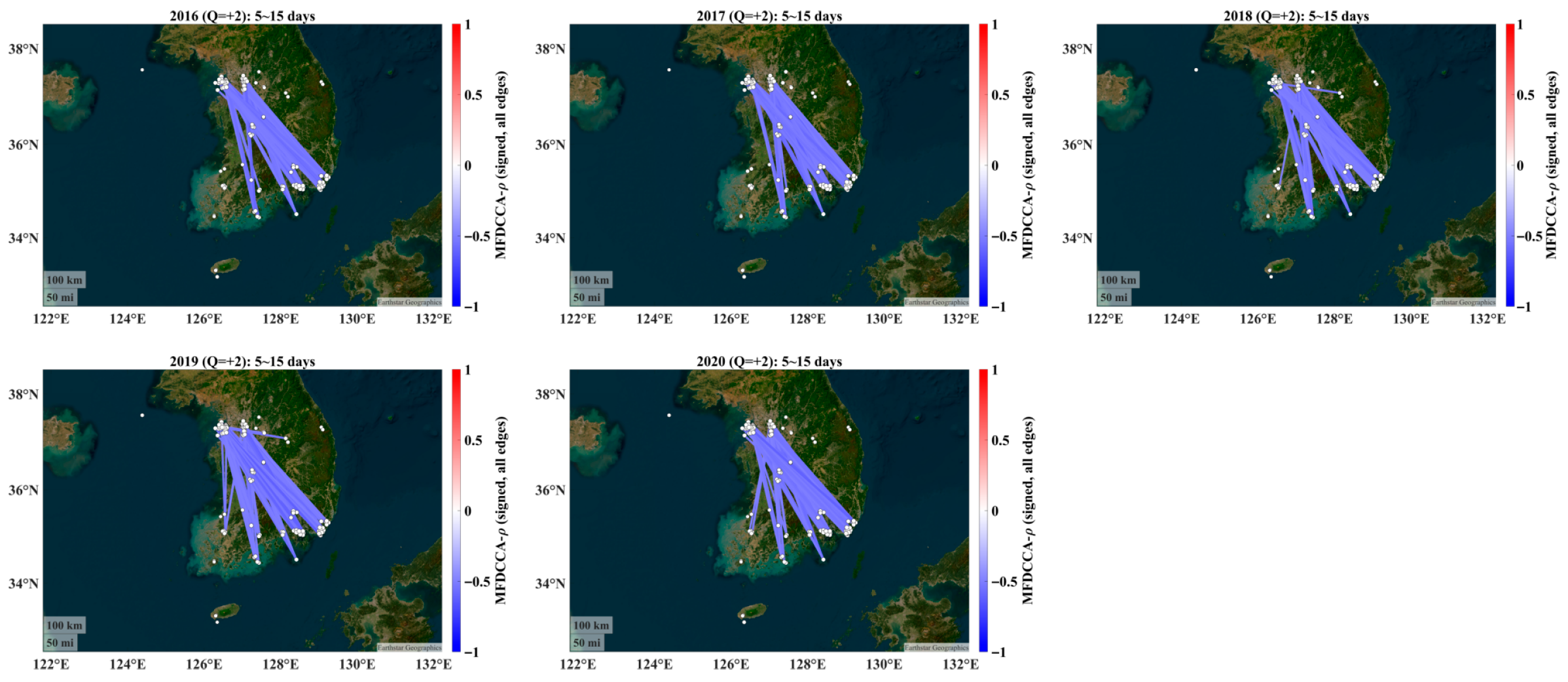

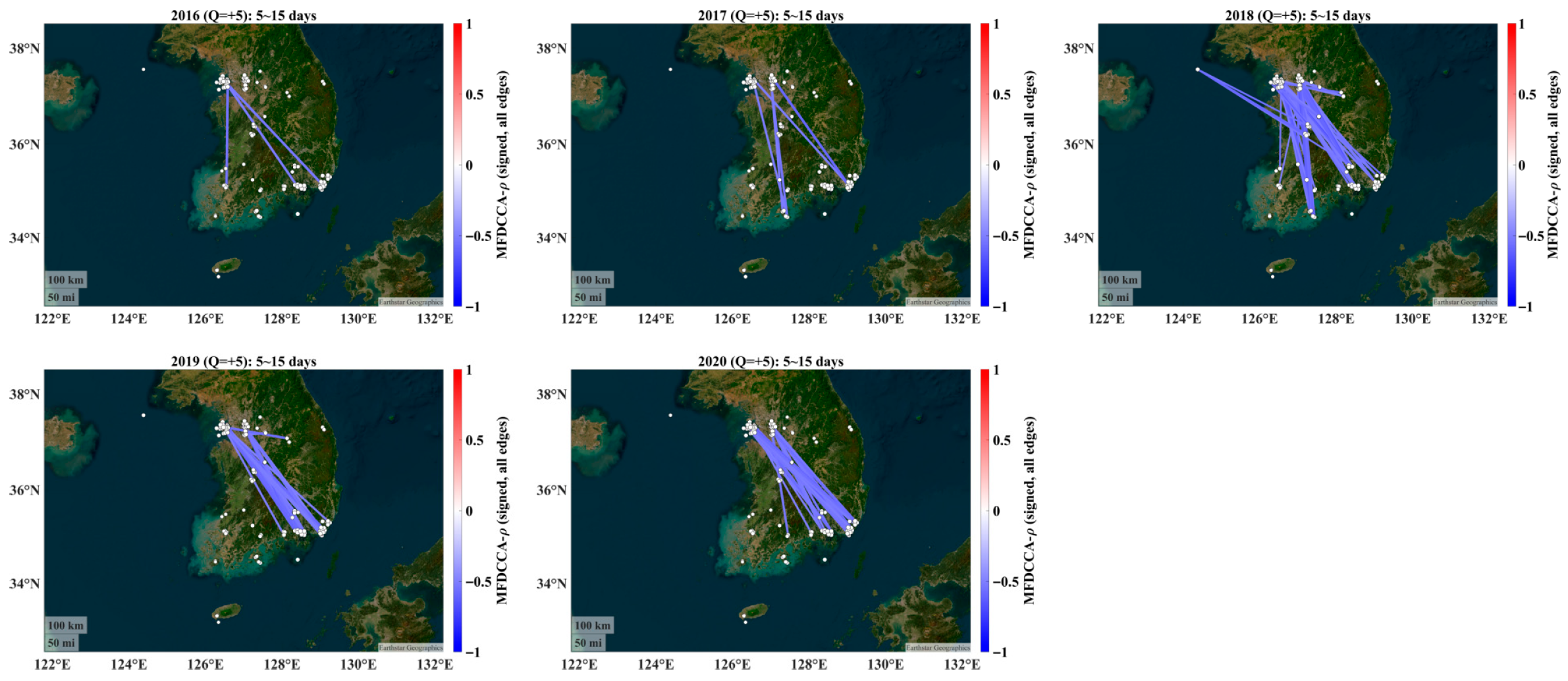

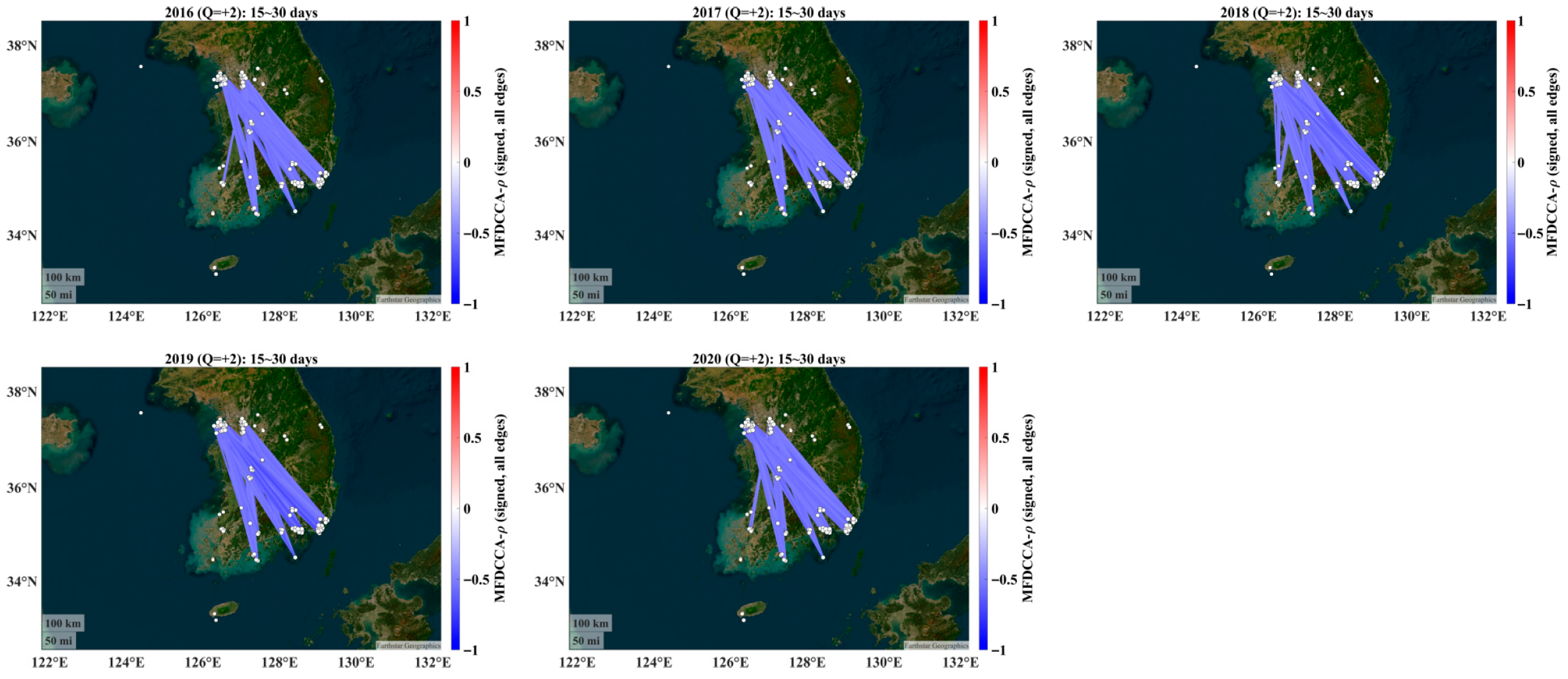
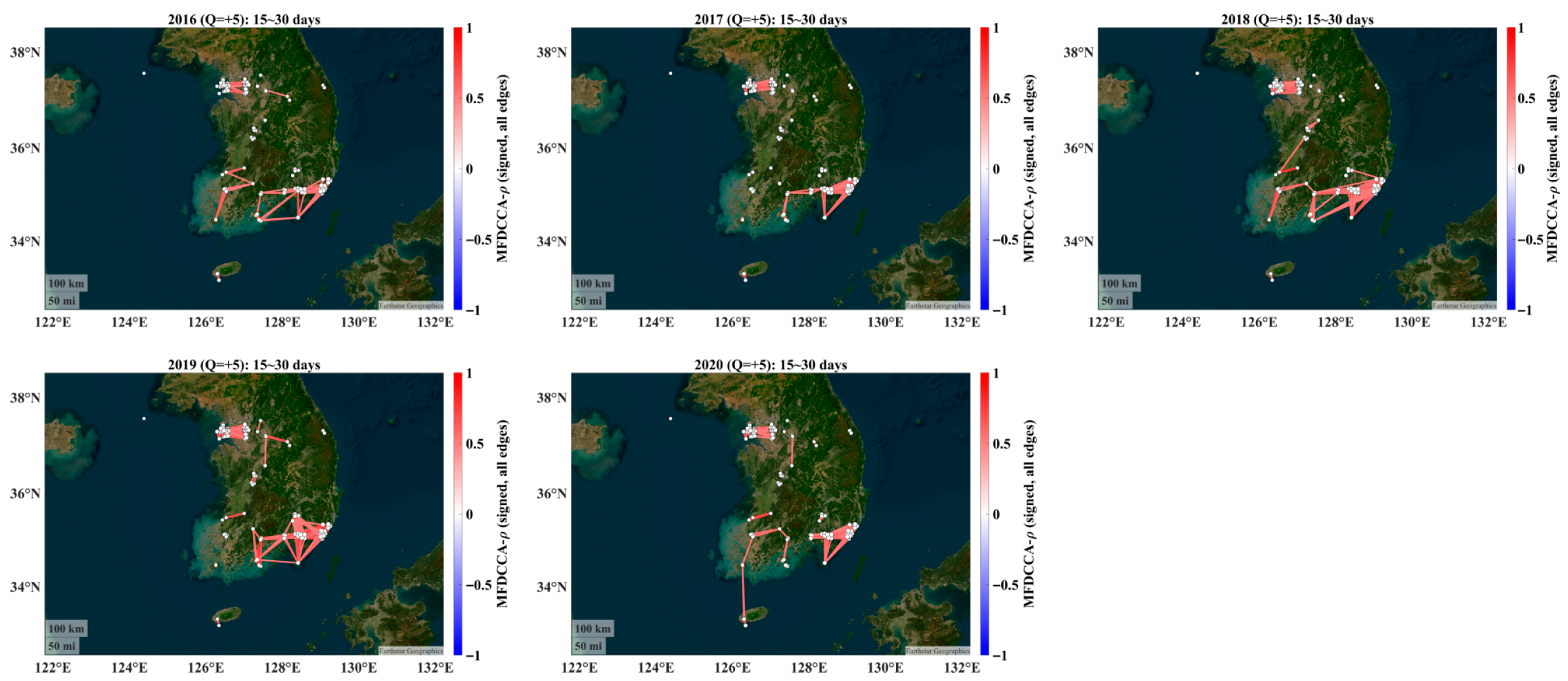

References
- Kim, K.-H.; Kabir, E.; Kabir, S. A review on the human health impact of airborne particulate matter. Environ. Int. 2015, 74, 136–143. [Google Scholar] [CrossRef]
- Srimuruganandam, B.; Nagendra, S. Source characterization of PM10 and PM2.5 mass using a chemical mass balance model at urban roadside. Sci. Total Environ. 2012, 433, 8–19. [Google Scholar] [CrossRef]
- De-Kok, T.M.C.M.; Driece, H.A.L.; Hogervorst, J.G.F.; Briede, J.J. Toxicological assessment of ambient and traffic—Related particulate matter: A review of recent studies. Mutat. Res. 2006, 613, 103–122. [Google Scholar] [CrossRef] [PubMed]
- Misra, C.; Geller, M.D.; Shah, P.; Sioutas, C.; Solomon, P.A. Development and evaluation of a continuous coarse (PM10–PM2.5) particle monitor. J. Air Waste Manag. Assoc. 2001, 51, 1309–1317. [Google Scholar] [CrossRef]
- Johansson, C.; Norman, M.; Gidhagen, L. Spatial & temporal variations of PM10 and particle number concentrations in urban air. Environ. Monit. Assess. 2007, 127, 477–487. [Google Scholar]
- Cheung, K.; Daher, N.; Kam, W.; Shafer, M.M.; Ning, Z.; Schauer, J.J.; Sioutas, C. Spatial and temporal variation of chemical composition and mass closure of ambient coarse articulate matter (PM10–2.5) in the Los Angeles area. Atmos. Environ. 2011, 45, 2651–2662. [Google Scholar] [CrossRef]
- Ocak, S.; Turalioglu, F.S. Effect of meteorology on the atmospheric concentrations of traffic-related pollutants in Erzurum, Turkey. J. Int. Environ. Appl. Sci. 2008, 3, 325–335. [Google Scholar]
- Zhang, H.; Wang, Y.; Hu, J.; Ying, Q.; Hu, X.M. Relationships between meteorological parameters and criteria air pollutants in three megacities in China. Environ. Res. 2015, 140, 242–254. [Google Scholar] [CrossRef]
- Haddad, K.; Vizakos, N. Air quality pollutants and their relationship with meteorological variables in four suburbs of Greater Sydney, Australia. Air Qual. Atmos. Health 2021, 14, 55–67. [Google Scholar] [CrossRef]
- Liu, Y.; Zhou, Y.; Lu, J. Exploring the relationship between air pollution and meteorological conditions in China under environmental governance. Sci. Rep. 2020, 10, 1–11. [Google Scholar] [CrossRef]
- Li, X.; Ma, Y.; Wang, Y.; Liu, N.; Hong, Y. Temporal and spatial analyses of particulate matter (PM10 and PM2.5) and its relationship with meteorological parameters over an urban city in northeast China. Atmos. Res. 2017, 198, 185–193. [Google Scholar] [CrossRef]
- Caramagna, A.; Famoso, F.; Lanzafame, R.; Monforte, P. Analysis of vertical profile of particulates dispersion in function of the aerodynamic diameter at a congested road in Catania. Energy Procedia 2015, 82, 702–707. [Google Scholar] [CrossRef]
- Kumar, N.; Park, R.J.; Jeong, J.I.; Woo, J.H.; Kim, Y.; Johnson, J.; Yarwood, G.; Kang, S.; Chun, S.; Knipping, E. Contributions of international sources to PM2. 5 in South Korea. Atmos. Environ. 2021, 261, 118542. [Google Scholar] [CrossRef]
- Lee, S.; Kim, J.; Choi, M.; Hong, J.; Lim, H.; Eck, T.F.; Holben, B.N.; Ahn, J.Y.; Kim, J.; Koo, J.H. Analysis of long-range transboundary transport (LRTT) effect on Korean aerosol pollution during the KORUS-AQ campaign. Atmos. Environ. 2019, 204, 53–67. [Google Scholar] [CrossRef]
- Yim, S.H.L.; Gu, Y.; Shapiro, M.A.; Stephens, B. Air quality and acid deposition impacts of local emissions and transboundary air pollution in Japan and South Korea. Atmos. Chem. Phys. 2019, 19, 13309–13323. [Google Scholar] [CrossRef]
- Choi, J.; Park, R.J.; Lee, H.M.; Lee, S.; Jo, D.S.; Jeong, J.I.; Henze, D.K.; Woo, J.H.; Ban, S.J.; Lee, M.D.; et al. Impacts of local vs. trans-boundary emissions from different sectors on PM2.5 exposure in South Korea during the KORUS-AQ campaign. Atmos. Environ. 2019, 203, 196–205. [Google Scholar] [CrossRef]
- Lim, G.; Min, S. Correlation Structures of PM2.5 Concentration Series in the Korean Peninsula. Appl. Sci. 2019, 9, 5441. [Google Scholar] [CrossRef]
- Podobnik, B.; Stanley, H.E. Detrended cross-correlation analysis: A new method for analyzing two nonstationary time series. Phys. Rev. Lett. 2008, 100, 084102. [Google Scholar] [CrossRef] [PubMed]
- Zhou, W.-X. Multifractal detrended cross-correlation analysis for two nonstationary signals. Phys. Res. E 2008, 77, 066211. [Google Scholar] [CrossRef]
- Oświecimka, P.; Drożdż, S.; Forczek, M.; Jadach, S.; Kwapień, J. Detrended cross-correlation analysis consistently extended to multifractality. Phys. Res. E 2014, 89, 023305. [Google Scholar] [CrossRef]
- Schreiber, T.; Schmitz, A. Surrogate time series. Phys. D Nonlinear Phenom. 2000, 142, 346–382. [Google Scholar] [CrossRef]
- Available online: https://www.airkorea.or.kr/web/pmRelay?itemCode=10007&pMENU_NO=108 (accessed on 1 April 2021).
- Kwapień, J.; Oświęcimka, P.; Drożdż, S. Detrended fluctuation analysis made flexible to detect range of cross-correlated fluctuations. Phys. Rev. E 2015, 92, 052815. [Google Scholar] [CrossRef]
- Kantelhardt, J.W.; Zschiegner, S.A.; Bunde, E.K.; Havlin, S.; Bunde, A.; Stanley, H.E. Multifractal detrended fluctuation analysis of nonstationary time series. Phys. A 2002, 316, 87–114. [Google Scholar] [CrossRef]
- Podobnik, B.; Jiang, Z.-Q.; Zhou, W.-X.; Stanley, H.E. Statistical tests for power-law cross-correlated processes. Phys. Rev. E 2011, 84, 066118. [Google Scholar] [CrossRef]
- Barrat, A.; Barthélemy, M.; Pastor-Satorras, R.; Vespignani, A. The architecture of complex weighted networks. Proc. Natl. Acad. Sci. USA 2004, 101, 3747–3752. [Google Scholar] [CrossRef]
- Newman, M.E.J. Assortative Mixing in Networks. Phys. Rev. Lett. 2002, 89, 208701. [Google Scholar] [CrossRef] [PubMed]
- Newman, M.E.J. Mixing patterns in networks. Phys. Rev. E 2003, 67, 026126. [Google Scholar] [CrossRef] [PubMed]
- Allabakash, S.; Lim, S.; Chong, K.-S.; Yamada, T.J. Particulate Matter Concentrations over South Korea: Impact of Meteorology and Other Pollutants. Remote Sens. 2022, 14, 4849. [Google Scholar] [CrossRef]
- Jun, M.-J.; Gu, Y. Effects of transboundary PM2.5 transported from China on the regional PM2.5 concentrations in South Korea: A spatial panel-data analysis. PLoS ONE 2023, 18, e0281988. [Google Scholar] [CrossRef]

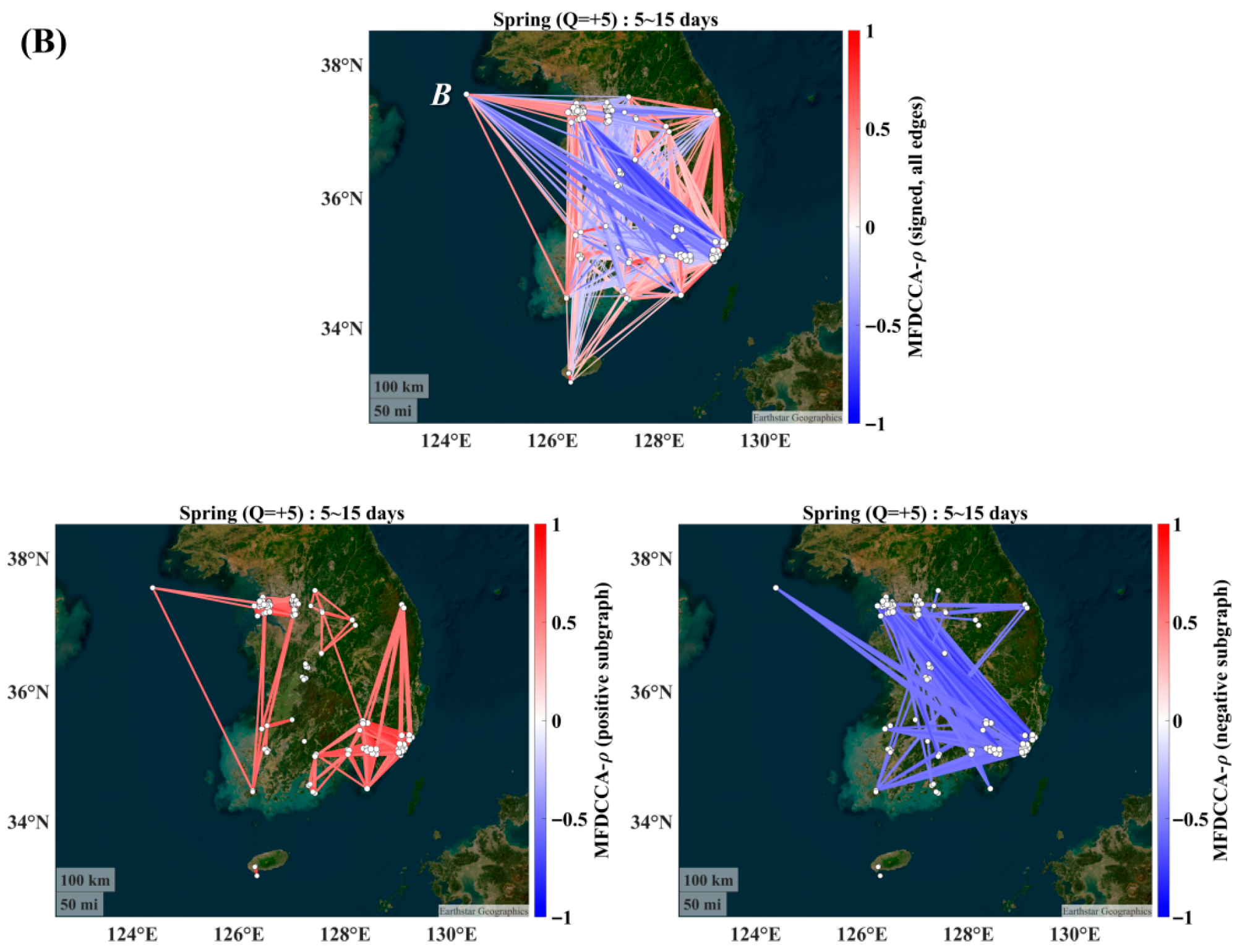

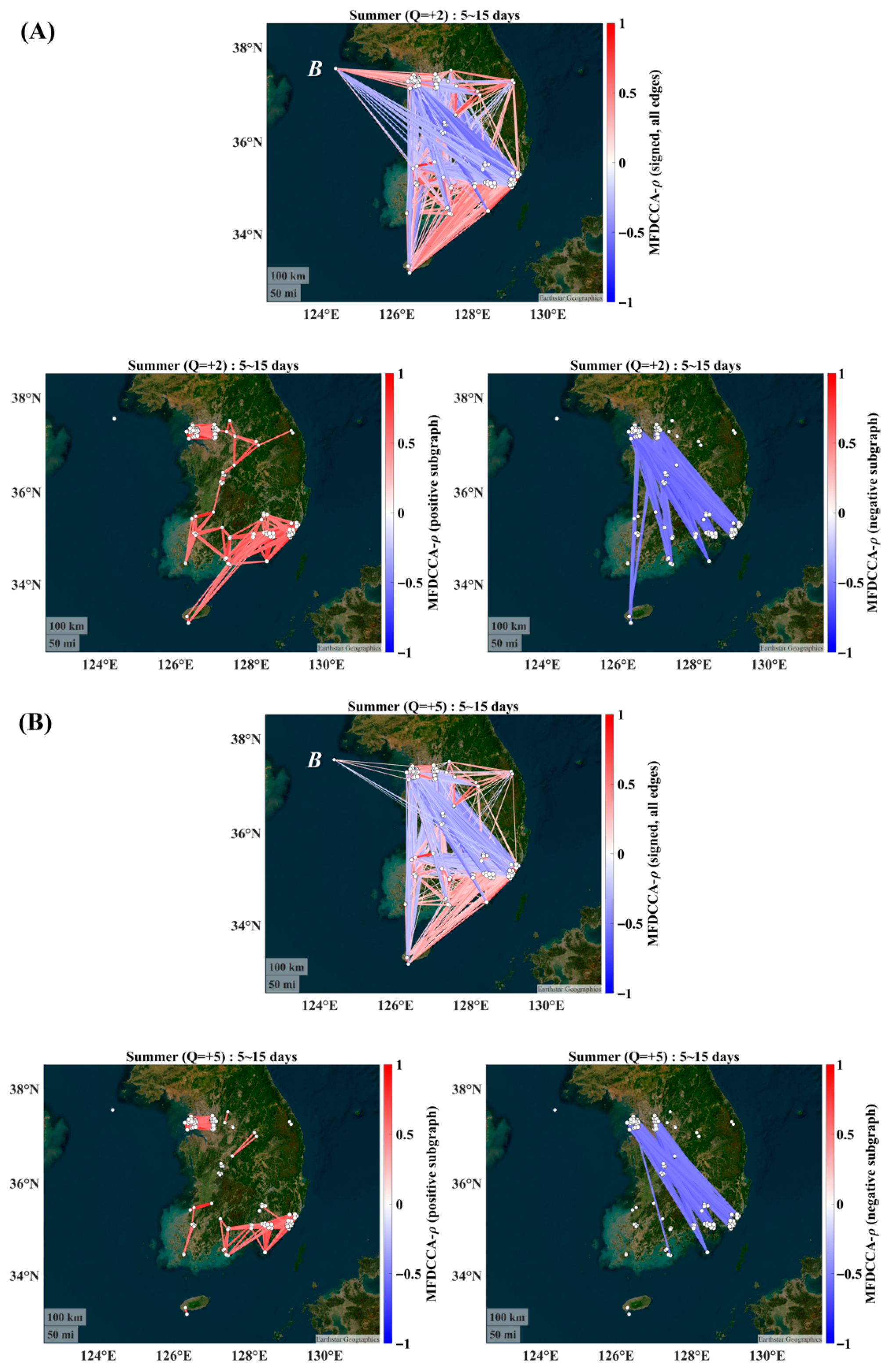
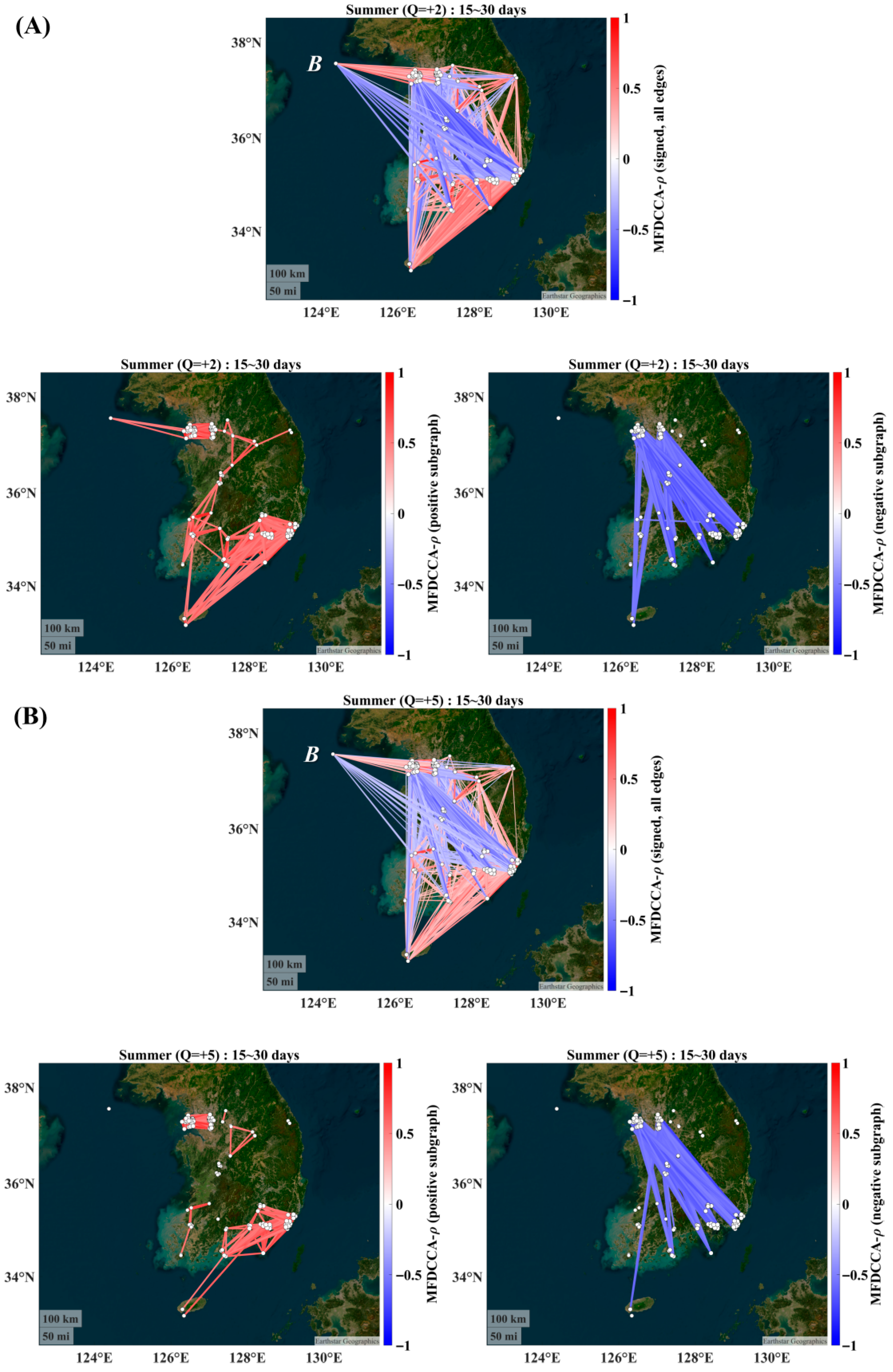



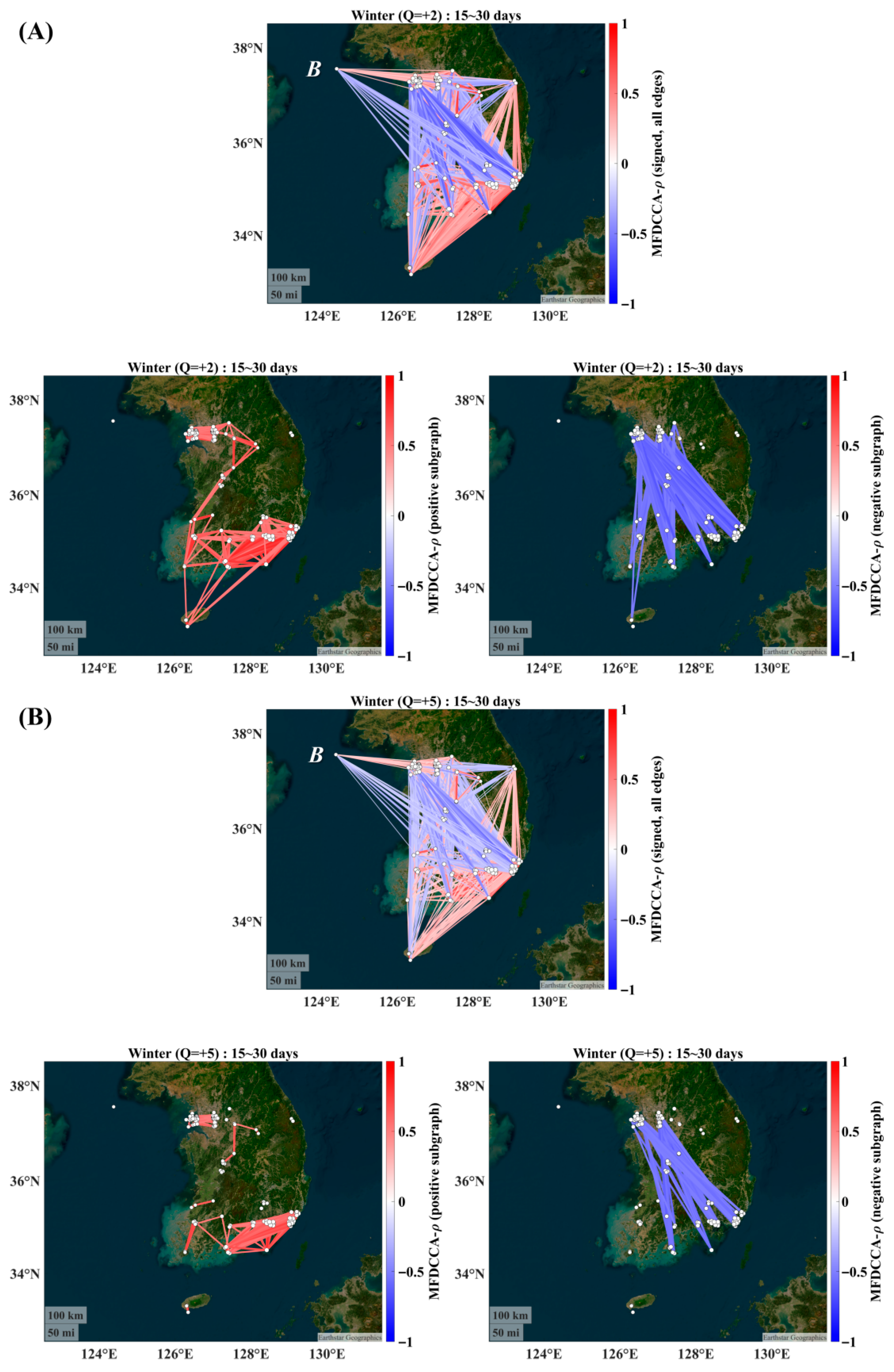
| Scale | ||||||
|---|---|---|---|---|---|---|
| Spring | 5~15 days | 0.3508 | 0.1870 | 5.4068 | 0.5597 | |
| 15~30 days | 0.3318 | 0.1782 | 5.2053 | 0.6073 | ||
| Summer | 5~15 days | 0.3367 | 0.1946 | 5.8434 | 0.6397 | |
| 15~30 days | 0.3378 | 0.2065 | 5.3975 | 0.6357 | ||
| Autumn | 5~15 days | 0.3419 | 0.1752 | 6.2290 | 0.4954 | |
| 15~30 days | 0.2994 | 0.1195 | 7.7471 | 0.4647 | ||
| Winter | 5~15 days | 0.3888 | 0.2129 | 6.4392 | 0.5079 | |
| 15~30 days | 0.3751 | 0.2008 | 6.1835 | 0.5388 | ||
| Spring | 5~15 days | 0.3473 | 0.1740 | 6.2661 | 0.4641 | |
| 15~30 days | 0.3049 | 0.1419 | 6.5345 | 0.5656 | ||
| Summer | 5~15 days | 0.2941 | 0.1420 | 8.3558 | 0.6011 | |
| 15~30 days | 0.2980 | 0.1502 | 7.4148 | 0.5180 | ||
| Autumn | 5~15 days | 0.3295 | 0.1652 | 5.7067 | 0.5199 | |
| 15~30 days | 0.2674 | 0.1049 | 7.4217 | 0.5406 | ||
| Winter | 5~15 days | 0.3534 | 0.1583 | 9.0248 | 0.4781 | |
| 15~30 days | 0.3051 | 0.1263 | 8.4184 | 0.5484 |
| Scale | ||||||
|---|---|---|---|---|---|---|
| Spring | 5~15 days | 0.4172 | 0.1845 | 3.5889 | 0.0696 | |
| 15~30 days | 0.3927 | 0.1758 | 3.4933 | 0.0549 | ||
| Summer | 5~15 days | 0.4086 | 0.1939 | 3.5446 | −0.0270 | |
| 15~30 days | 0.3837 | 0.2067 | 3.2482 | 0.0602 | ||
| Autumn | 5~15 days | 0.4082 | 0.1736 | 3.7462 | 0.0831 | |
| 15~30 days | 0.3735 | 0.1653 | 3.6393 | 0.0728 | ||
| Winter | 5~15 days | 0.4320 | 0.2130 | 3.2202 | 0.0473 | |
| 15~30 days | 0.4221 | 0.2031 | 3.1733 | 0.0475 | ||
| Spring | 5~15 days | 0.3646 | 0.1567 | 4.2701 | 0.0940 | |
| 15~30 days | 0.3441 | 0.1319 | 4.4154 | 0.0432 | ||
| Summer | 5~15 days | 0.3276 | 0.1241 | 4.8972 | 0.0157 | |
| 15~30 days | 0.3135 | 0.1354 | 4.5073 | 0.0329 | ||
| Autumn | 5~15 days | 0.3322 | 0.1069 | 5.2794 | 0.0372 | |
| 15~30 days | 0.2823 | 0.0938 | 5.2286 | 0.1028 | ||
| Winter | 5~15 days | 0.3859 | 0.1483 | 4.3051 | −0.0248 | |
| 15~30 days | 0.3481 | 0.1150 | 4.8347 | −0.0033 |
Disclaimer/Publisher’s Note: The statements, opinions and data contained in all publications are solely those of the individual author(s) and contributor(s) and not of MDPI and/or the editor(s). MDPI and/or the editor(s) disclaim responsibility for any injury to people or property resulting from any ideas, methods, instructions or products referred to in the content. |
© 2025 by the authors. Licensee MDPI, Basel, Switzerland. This article is an open access article distributed under the terms and conditions of the Creative Commons Attribution (CC BY) license (https://creativecommons.org/licenses/by/4.0/).
Share and Cite
Lim, G.; Min, S. Season-Resolved, Fluctuation-Level Regional Connectivity of PM2.5 over the Korean Peninsula Revealed by Multifractal Detrended Cross-Correlation Networks (2016–2020). Fractal Fract. 2025, 9, 737. https://doi.org/10.3390/fractalfract9110737
Lim G, Min S. Season-Resolved, Fluctuation-Level Regional Connectivity of PM2.5 over the Korean Peninsula Revealed by Multifractal Detrended Cross-Correlation Networks (2016–2020). Fractal and Fractional. 2025; 9(11):737. https://doi.org/10.3390/fractalfract9110737
Chicago/Turabian StyleLim, Gyuchang, and Seungsik Min. 2025. "Season-Resolved, Fluctuation-Level Regional Connectivity of PM2.5 over the Korean Peninsula Revealed by Multifractal Detrended Cross-Correlation Networks (2016–2020)" Fractal and Fractional 9, no. 11: 737. https://doi.org/10.3390/fractalfract9110737
APA StyleLim, G., & Min, S. (2025). Season-Resolved, Fluctuation-Level Regional Connectivity of PM2.5 over the Korean Peninsula Revealed by Multifractal Detrended Cross-Correlation Networks (2016–2020). Fractal and Fractional, 9(11), 737. https://doi.org/10.3390/fractalfract9110737






